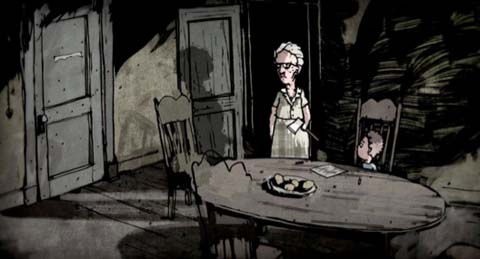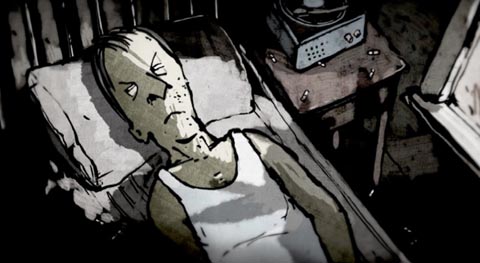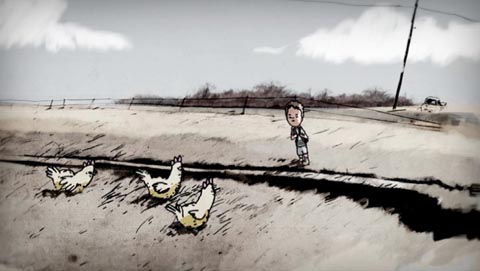

Jason Carpenter Talks About his Annie-Nominee “The Renter”

I’m glad we haven’t compiled our year-end list of favorites yet because last weekend I encountered one of the best shorts I’ve seen in a long time: Jason Carpenter’s The Renter.
The film snuck up on me. I only learned about its existence after the filmmaker emailed me a few days ago inviting me to preview it on-line. The Renter is currently nominated for an Annie Award. It’s perhaps a long shot against formidable competitors that include big-budget CG shorts from Pixar and Warner Bros. and an entry from perennial indie Bill Plympton, but there’s no question in my mind which of the nominees is the most emotionally captivating, artistically innovative, and viscerally beautiful. The Renter is certainly the one that will remain with me for the longest time.
Before we proceed further, here’s the trailer:
The Renter transports viewers into a rustic American landscape. Water towers and farmhouses standing in stoic isolation, lonely stretches of two-lane roads, and trains inching across rolling fields are images that will feel instantly familiar to anyone who grew up in certain rural regions of the United States. This Americana backdrop frames a story about the often overwhelming experiences of childhood. Carpenter masterfully builds the tension in his dialogue-less film while subtly revealing his young character’s feelings and experiences. He avoids filmic cliches of heroes and villains instead focusing on the humanity of the story.
The animation style and background paintings in The Renter exhibit uncommon grace and spontaneity, all the more surprising considering the short was created entirely within the computer. Carpenter’s use of color, limited in palette but rich in tone and texture, is pure visual poetry. His expert use of cinematographic techniques (staging, pacing, match cuts, and light and shadow) conceal any hints that this is his first professional short.
I conducted an interview via e-mail with Jason earlier this week. We discussed the film’s long path to completion, his personal history, how he created the film, and how he supported himself financially while making the short.
AMID AMIDI: Tell us a little bit about yourself. Where are you from? Where did you go to school? I was surprised to read on the film’s site that this was your first film because it looks like you’ve been making them for years. Have you done a lot of animation before?
JASON CARPENTER: Well, let’s see . . . my name’s Jason, my brother calls me Breamis, and I grew up in Greensboro, NC. I went to undergrad at the College of Design at NC State and got a graduate degree in Experimental Animation from CalArts. Yeah, The Renter is my first film. I’ve worked professionally in animation for a while–for TV, other people’s films, theme parks, museums, and teaching–but this is the first film I’ve made all on my own.
AA: Was there any specific filmmaker or films that inspired you to pursue animation as a career?
JC: This might sound funny, but they were all painters. I couldn’t even name them all. Some of my favorites are Egon Schiele, Lucian Freud, Francis Bacon, David Hockney, Paula Rego, and the German Expressionists. I love image making and the texture of paint. I think I went into animation because I could make those paintings move.
AA: So how does your painting background influence your animation?
JC: The process. I think of the still images first. Then they sort of come alive. I think painting is a process of discovery. You never really know what you’re going to end up with. You start with an idea and end with a picture. The fun part is how you get there. When you work on a painting, sometimes paint drips and gets splattered in places you never intended. I try to incorporate this into the way I worked on the film. I like letting the process lead me. Filmmaking takes so long. You have to be in it for the journey. If you can’t enjoy the process at some level, you’ll be pretty unhappy.
AA: In the notes about The Renter, you spoke about how the film is rooted in childhood experiences of attending a home daycare run by an elderly woman. Is the story based on a particular incident or specific “renter,” or is it a composite of memories accumulated over many visits to the place?
 JC: Actually both. In one way or another, all the events in the film occurred in real life (except the soup sequence). The film is based on my memory of a lot of visits. I stayed with Mommy Eldridge in the afternoons until I was about 8 years old. The “renter” character is based on a particular man who rented a room from her one summer. He worked the 3rd shift at the railroad behind her house and slept during the day. One morning I was too loud, and I woke him up. He got so angry he chased me around with a belt. Of course Mommy Eldridge protected me, and, despite how I portrayed her in the film, she was actually a very loving and kind woman that I remember quite fondly.
JC: Actually both. In one way or another, all the events in the film occurred in real life (except the soup sequence). The film is based on my memory of a lot of visits. I stayed with Mommy Eldridge in the afternoons until I was about 8 years old. The “renter” character is based on a particular man who rented a room from her one summer. He worked the 3rd shift at the railroad behind her house and slept during the day. One morning I was too loud, and I woke him up. He got so angry he chased me around with a belt. Of course Mommy Eldridge protected me, and, despite how I portrayed her in the film, she was actually a very loving and kind woman that I remember quite fondly.
AA: In an earlier email you hinted that the film had a long gestation period. Can you talk more about the history of this project. How would the film have been different if you’d just kept pushing ahead on the original version instead of restarting the whole thing?
JC: Here are some pieces of silent animation from the first version:
It’s an interesting comparison. The Renter took quite a while to come into its own. I started working on it at CalArts. When I graduated, the story was there, as well as a lot of animation, but I still felt it was more of an outline than a finished film. If I had kept moving forward then, I think the film would be missing much of what it is today. When I started the production over again at the beginning of last year, I really tried to simplify what I had. I took out anything that wasn’t necessary and pushed the painterly aspects of the style more. In the end, although the story never really changed, I think I did a better job of telling that story in a more visually interesting way.
AA: What was the biggest challenge for you in producing this film?
JC: Picking a path. I think that’s always it. For me, the most seductive part of filmmaking is the beginning, when anything is possible. Ideas are such beautiful things. As soon as you give them a name, a little of their magic is lost. The goal, I think, is to hold on to the essence of an idea and let it guide you forward. To make progress, you have to make a choice. Some things that are really great have to get thrown out for the greater good. You have to put faith in yourself and your process that you’ll make the right choices. I think the hardest part is having the courage to set all those other possibilities aside and make that “one” thing.
AA: You worked on the film for most of 2009 and 2010. There’s not exactly a lot of arts funding in the US so I’m curious how you managed financially for those two years?
JC: Making a short film is such a personal investment. A couple of years ago, when a major project at work finished, my wife (I never could have done it without her) and I decided I should take the time to finish the film. We also made the decision that not finishing was not an option. I worked at home on the film while she went to work. We made up the difference with our savings. Our strategy was for me to “barrel through” it and get it finished in 8 months. When the deadline came and went, we realized it was going to take a lot longer and cost more than we thought. Isn’t that always the case? Making The Renter was a major emotional and financial sacrifice. Now that I’m finished, I’m finally able to say what I couldn’t for two years. It was worth it.
With a film, you never really know what you’ll get in the end. That’s one of the hardest parts of being an artist. It’s a tremendous sacrifice putting independent animation into the world. Whether the finished project is good or bad only matters so much. It doesn’t make the process any less of a struggle. The heart and soul invested isn’t worth any less. As Americans, I think we get so focused on the slick, final product, that we often forget what artists go through to create something. That struggle is something that should be supported and celebrated.

AA: The drawing and settings feel incredibly organic for what you label an “all-digital paperless production.” Talk more about your digital workflow. Did you scan in textures or brushstrokes?
JC: Except for some early drawings and thumbnails, I didn’t use any paper. I really tried to approach the digital production the same way I would if I were using traditional mediums. Before I started the animation, I blocked out rough layouts and animatics in Flash. With some basic brushes and a couple of paper textures I got from a friend, I started working on the backgrounds in Photoshop. The “texture” of the film results more from how I worked with the tools I had and not so much what tools they were. In many ways, that was my favorite part of the process. I loved painting the backgrounds. The animation helped me tell the story, but the backgrounds helped me feel it, and that’s something I really enjoyed.
AA: Who or what is inspiring you at the moment, in animation or in film, art and beyond?
JC: Wow. . . a lot of things. Anything that helps me tell a visual story. Some of the inspiration for The Renter actually came from reading The Grapes of Wrath. Steinbeck’s writing is so vivid that images just seem to jump off the page. The same thing happens with music. I’ve been listening to a lot of “Iron and Wine” lately; his music really speaks to me. I continue to find a lot of inspiration in still imagery, whether it’s illustration or painting. Being exposed to a lot of different styles and ways of working is really helpful. I love seeing what other people are doing.
AA: On your company website for Carpenter Bros. Animation, I noticed you’ve had a long creative partnership with your brother and you attended CalArts together…
JC: My brother and I have worked together for a lot of our professional careers. We complement each other very nicely and can pretty much complete each other thoughts at this point. Creatively, it’s been very helpful. Two heads are usually better than one. It’s truly an asset to have someone to bounce ideas off of that understands you as well as being your brother. After living in New York for a while, we went back to CalArts to study animation. Recently, we’ve each been working on our own films independently, but I think we’ll be working together again soon.
AA: How do you plan to distribute The Renter? What else are you working on nowadays? Do you have plans to make more films?
JC: I’d love to get it out there anyway I can. I’m really excited about the Annie nomination. That was a wonderful surprise. I’m honored to be up against such tough competition. Recently, I’ve been applying to festivals and trying to show it to as many people as possible. At some point I’d love to do a gallery show of the artwork in and behind the film.
Currently, I’m working on an animated TV spot and doing some creative consulting for a theme park. I’d love to make more films. I’ve got lots of ideas, but I’d approach the production differently. I made The Renter all by myself; next time I’d love to have some help!
Making this film was a very challenging, but enjoyable experience. I’m truly excited to see what comes next. There’s a lot out there, and I love doing different things. I’m ready for new and exciting opportunities!
Visit the film’s official website at TheRenter.net.


.png)